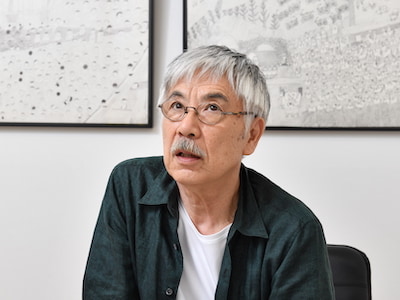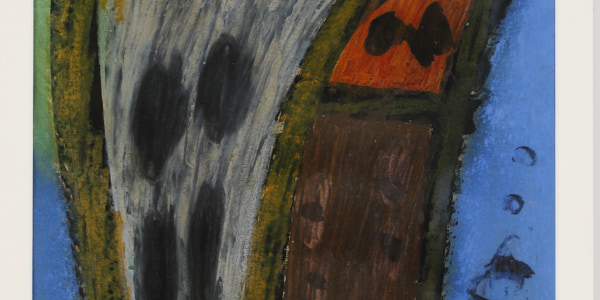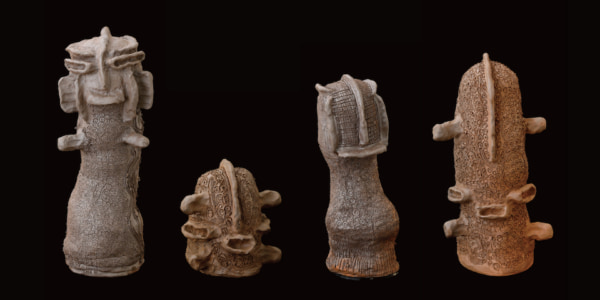Co-starring
HIRASE Toshihiro(1971-)
Hirase was born in 1971. He lives in Fukagawa City, Hokkaido. He creates pictures by drawing countless “X” marks according to his own set of rules. It takes two to three months to complete a single picture. This style got its start when he drew eight “X”s in the corner of notebook in 2001. Thereafter, he began creating complex patterns with “X”s as if spelling out words. His works have been shown in the Hokkaido Outsider Art Exhibition at the Asahikawa Museum of Art in 2009, and the Art Brut Japonaise exhibition at the Halle Saint Pierre art museum in Paris in 2010.
![[Photograph (Works)]](https://staging2022.diversity-in-the-arts.jp/admin/wp-content/uploads/2022/05/f83d795b335c0049981d0be0f4ee7ae1-1.jpg)
“Untitled II” / 297×420mm / Pencil and permanent marker on paper / 2006 / Collection of The Nippon Foundation
A French architect was charmed by King Khufu’s pyramid in Egypt and wanted to build an identical pyramid in Paris. He needed blueprints to build the pyramid, so he visited Egypt over and over again, creating this exploded view.
The entire pyramid, including everything outside and in, is drawn on this single sheet of paper.
Put it together in 3D and it makes a pyramid, you see.
This plan should have been sufficient to build the pyramid, but just in case, the architect used infrared light to scan the pyramid’s interior, creating another exploded view. When he did so, the result was something completely different than before.
![[Photograph (Works)]](https://staging2022.diversity-in-the-arts.jp/admin/wp-content/uploads/2022/05/6cd00ae8b369c08e81cb73fa69c648a8-1.jpg)
“Untitled III” / 600×901×33mm / Pencil and permanent marker on paper / 2006 / Collection of The Nippon Foundation
Using infrared light revealed a different structure.
Well there was no helping it, so the architect took the first exploded view and the infrared exploded view and combined them together to create this exploded view.
![[Photograph (Works)]](https://staging2022.diversity-in-the-arts.jp/admin/wp-content/uploads/2022/05/f2ff4803db3eb1cb06e60fe8c08e34a3-1.jpg)
“Untitled I” / 530×780×18mm / Pencil and permanent marker on paper / 2001 / Collection of The Nippon Foundation
In order to make different parts of the flat surface 3D, the architect drew an even more detailed exploded view, adding figures, as well, such as this part was such-and-such centimeters, and this part so-and-so meters.
You’ve probably seen furniture like that before. It comes with an instruction manual and if you assemble the pieces according to it, you can put together the furniture together. Because the architect went so far as to use infrared light, the plan was very complex, but if you could figure it out, you could build the pyramid. The architect hired a contractor, and the contractor deciphered the exploded view accordingly and built King Khufu’s pyramid on a vacant lot in Paris. It was built life-sized and everything down to the interior was exactly the same.
The stones the contractor used however, were not the stones used thousands of years ago. The only stones the contractor could use were those we use nowadays, but at any rate the pyramid was the spitting image of King Khufu’s pyramid.
The architect was absolutely delighted that his dream had been realized. He entered the pyramid, going to the king’s chamber and the grand gallery, and climbing up and down the stairs. However, as he was doing so, his excitement gradually began to fade. He realized that something was missing.
What was it? He checked the plan over and over again, but hadn’t the tiniest idea. His pyramid was supposed to be an exact copy, everything the same down to the smallest detail, and yet something was definitely missing.
Just thinking about it wasn’t revealing the answer, so he went once more to King Khufu’s pyramid. When he went inside, he realized what was clearly different.
“Now I see; my pyramid has no spirit,” he thought.
For centuries, pyramids have existed as tombs. Some have a frightening vindictiveness, while others have a more pure and gentle atmosphere. For lack of a better word, we can only call this the pyramid’s “spirit.” Perhaps we could even call it its “soul.” In short, the architect realized that without this spirit, his pyramid could never be a true pyramid.
There was no way to copy this. Nothing to be done.
The architect had built his pyramid, but feeling there was nothing else he could do and in despair, he got rid himself of it.
He had thought that once he built the pyramid, he would be able to have fun visiting it every day, so now he was crushed.
**
Why, however, had the architect been so passionate about building King Khufu’s pyramid?
At first, he had simply loved pyramids and found the excitement of entering them endlessly enjoyable. Gradually, he began wanting not only to go inside pyramids but also to build for himself his own pyramid, to become a pyramid himself. I imagine it was this kind of sentiment, the kind only an architect would have, which welled up inside him.
He wanted to get down on the ground, trace the pyramid’s lines with his own hands, and grasp the pyramid within himself.
He thought a pyramid would be easy to create if only one had the skills to do so. It was only after he made his, however, that he understood that only getting the exterior, only getting the materials perfect does not a pyramid make.
After the architect gave the pyramid up, it became a place where children played and was used for all kinds of events. From the high and noble thing the architect had hoped for, it suddenly became something quite humble and base.
Naturally, people called it “the pyramid.”
“Let’s go to the pyramid this Sunday.”
“Let’s go on a date at the pyramid.”
“There’s going to be a concert at the pyramid.”
So they would say. The people of Paris embraced the pyramid a five-minute walk away as a part of their lives, enjoying it thoroughly. Even though, to the architect, it had become a boondoggle.
…And that’s where I intended to end our story, but that would be far too sad for the architect, so I decided to do a little more wild imagining on what happened thereafter.
One day, the architect felt a funny sensation inside. Thinking perhaps there was something wrong with his stomach, he had an X-ray taken, and at the bottom of his stomach, they found something quadrangular pyramid-shaped. That’s right, he had a pyramid inside of him.
It was not especially painful or uncomfortable; the architect was quite healthy.
In fact, prior to this, the architect had had a terrible sense of direction, but now that was no longer an issue. Conversely, he now had such a good sense of direction, he could tell whether he was facing north-northwest or west-northwest. He had become a master of direction!
Also, every night, King Khufu would appear in his dreams, and give him lectures on various things about Egypt. Of course people wouldn’t believe it even if he told them, so he began turning it into a book instead.
He titled it, “The Definitive Unraveling of the Mysteries of the Pyramids.”
Watching the children play on the pyramid he had built, now he taps away at his computer having the time of his life.
![[Photograph] 手には万年筆を握り原稿用紙に向かいながらも、満足そうな表情で大福を頬張るイッセー尾形さん。](https://staging2022.diversity-in-the-arts.jp/admin/wp-content/uploads/2022/05/A2A9476_960-1.jpg)
[Corporation] Yanaka no Okatte, NPO Taito Cultural & Historical Society, Ueno-Sakuragi Denchu Hirakushi House and Atelier
![[Photograph] 大福を左手にもちながらも、一心不乱に原稿用紙へとむかうイッセー尾形さん。和室にて。](https://staging2022.diversity-in-the-arts.jp/admin/wp-content/uploads/2022/05/A2A9431_1600-1.jpg)



